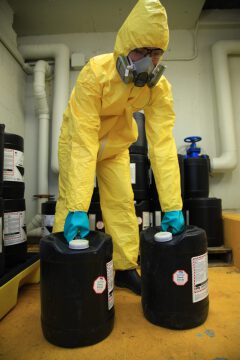What is a risk?
Definition :
Risk refers to the possibility of experiencing harm, loss, or adverse effects resulting from exposure to Hazards.
Example :
Exposure of a worker to spilled oil.

Example :
The operator handles the containers, so he is exposed to hazardous chemicals. We say that the operator is exposed to hazards because there is a possibility of something bad happening.

Note :
Note that risk is exposure to a hazard that likely causes harm.
(Risk = Hazard + Exposure)
Extra :
Understanding risk involves considering several vital aspects:
Probability of occurrence: measures how likely a hazard will lead to a harmful event.
Severity of impact: assesses the potential extent of damage or harm that could result from the risk.
Example : Example of probability of occurrence
Situation n° 01 : A laboratory analyst is measuring the pH of groundwater and handles hundreds of samples daily.
Analysis of the situation n° 01 : In this case, the likelihood of a container spilling and exposing the analyst to groundwater would be high.
----------------------------------------------------------------------------
Situation n° 02 : An other laboratory analyst is conducting research on electroplating[1] with cyanide[2] baths and only uses the bath monthly.
Analysis of the situation n° 01 : The probability of an occurrence happening would be low.
Example : Example of severity of impact
Situation n° 03 : The severity of impact for a laboratory analyst measuring the pH of groundwater samples would likely be No Risk in the event of a “failure” that caused a laboratory analyst to be exposed to the groundwater.
----------------------------------------------------------------------------
Situation n° 04 : The severity of impact for a laboratory analyst conducting electroplating research with cyanide baths would be High in the event of a “failure” that caused an employee to be exposed to cyanide.